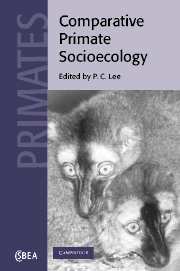Book contents
- Frontmatter
- Contents
- List of contributors
- Preface
- Part 1 Comparative methods
- Part 2 Comparative life history and biology
- Part 3 Comparative socioecology and social evolution
- 10 Lemur social structure and convergence in primate socioecology
- 11 Why is female kin bonding so rare? Comparative sociality of neotropical primates
- 12 Energetics, time budgets and group size
- 13 Ecology of sex differences in great ape foraging
- 14 Hominid behavioural evolution: missing links in comparative primate socioecology
- 15 Evolutionary ecology and cross-cultural comparison: the case of matrilineal descent in sub-Saharan Africa
- Editor's conclusion: Socioecology and social evolution
- Index
10 - Lemur social structure and convergence in primate socioecology
Published online by Cambridge University Press: 24 August 2009
- Frontmatter
- Contents
- List of contributors
- Preface
- Part 1 Comparative methods
- Part 2 Comparative life history and biology
- Part 3 Comparative socioecology and social evolution
- 10 Lemur social structure and convergence in primate socioecology
- 11 Why is female kin bonding so rare? Comparative sociality of neotropical primates
- 12 Energetics, time budgets and group size
- 13 Ecology of sex differences in great ape foraging
- 14 Hominid behavioural evolution: missing links in comparative primate socioecology
- 15 Evolutionary ecology and cross-cultural comparison: the case of matrilineal descent in sub-Saharan Africa
- Editor's conclusion: Socioecology and social evolution
- Index
Summary
Introduction
The study of social relationships lies at the core of socioecology, which attempts to explain social behaviour as an adaptation to ecological factors. Studies of primates have featured prominently in this field (Emlen and Oring, 1977; Rubenstein and Wrangham, 1986; Standen and Foley, 1989), partly because this comparatively small mammalian order exhibits stunning variation in both social organisation (i.e. size and composition) and structure of individual societies (Smuts et al., 1987). This chapter focuses on social structure, which is defined by the complex network of behavioural interactions among members of a society (Hinde, 1976). Differences in the patterning and nature of these interactions give rise to particular social relationships between pairs of individuals. Consistent features of these dyadic relationships, in turn, can be used to characterise the social structure of a society or even a taxon.
The specific aim is to portray the social structure of lemur societies and examine the evolutionary forces that have shaped them. This focus on lemurs (Lemuriformes) is particularly interesting from a comparative perspective because the living primates of Madagascar represent the endpoints of an adaptive radiation following a single colonisation event more than 50 million years ago (Yoder et al., 1996), and, thus, offer an opportunity to examine patterns of convergent evolution (Kappeler and Ganzhorn, 1994). In addition, phylogenetic reconstructions revealed that group living, i.e. the permanent association of more than two adults, evolved at least twice independently among lemurs, compared to only once among anthropoids (Kappeler, 1998). Furthermore, lemurs deviate in several basic features of their behavioural ecology and life history from most anthropoids (see below, and van Schaik and Kappeler, 1996).
- Type
- Chapter
- Information
- Comparative Primate Socioecology , pp. 273 - 299Publisher: Cambridge University PressPrint publication year: 1999
- 17
- Cited by



